I never would have imagined that five forts would be included in a
National Seashore, nor that three of them would be located inside Naval
Air Station Pensacola, an active military installation:

But they are -- and the best thing is that the public is
encouraged to visit them.
Numerous folks come on base to see the
Blue Angels precision aerial demonstration team do their practices in
the spring and to visit the National Naval Air Museum. Not as many know about the fortifications but
they may as well extend
their visit to include those, too.
Start your visit at the Fort Barrancas Visitor Center, where you can
watch a 15-minute video about the various fortifications, peruse the
exhibits, talk to National Park rangers, and pick up brochures and maps
of the structures and trails on site.

You can tour the visitor center, fort, and water battery in a couple
hours or less. Add more time to tour the Advanced Redoubt and walk one or
both trails in the park.
Both trails begin at the visitor center. A half-mile Woodland Nature Trail
loops through pleasant maritime forest terrain. I walked it on one of
my four visits to the fort area.
The Trench Trail connects the fort to the Advanced Redoubt but we drove to it
one day we were in a hurry, instead of walking.
WHY GUARD THE BAY?
Because we weren't the only ones interested in claiming this
territory!
The U.S. Army built Fort Barrancas in the 1840s as one of four
fortifications to protect Pensacola Bay and the Navy Yard from attack.
What I count as the fifth fortification is the Spanish Water Battery,
located just below Fort Barrancas. France and Britain were also
interested in governing this area since its discovery by Europeans 'way
back when.
This photo I "shot" from a video at the visitor center shows the
relative locations of all the fortifications and the Navy Yard:

Fort Pickens on Santa Rosa Island and Fort McRee on Perdico Key
guarded the channel from attack by sea. Fort Barrancas and its water battery, situated on a bluff facing the
harbor entrance, could support their crossfire and fire shots at ships
that entered the bay and harbor.
The Navy Yard was also vulnerable from land attacks from the north,
so the Advanced Redoubt was built to protect it and Fort Barrancas.
During the Civil War the Confederates briefly
held Fort Barrancas and exchanged gunfire with Federal forces at Fort Pickens.
SPANISH WATER BATTERY
It all began with Spain.
Or maybe Britain. (Not sure when the French encroached.)
The first fortification guarding the bay was the white-stuccoed,
semi-circled structure shown below Fort Barrancas in the next photo:

The Bateria de San Antonio was built in 1797. After recapturing the
Pensacola area from the British, the Spanish decided to construct this
fortification as part of a plan to strengthen harbor defenses. The maximum
range of smoothbore cannon at that time was about one mile. Americans modified
and armed the battery while building Fort Barrancas in the 1840s.
We could walk down to and around the water battery from the fort but couldn't
go inside the structure either time we wandered through the fort:



I liked how photogenic this building is. I'm guessing it's open at
certain times for public viewing but we just weren't there at the right time.
PHOTOS OF FORT BARRANCAS
The fort can be accessed by walking up a pathway from the visitor
center to an overlook on the bluff, where you can read interpretive panels
about the fort and water battery and peer out to Pensacola Bay and the entrance
to the harbor:


A fork in the path leads to the drawbridge, where you can see
the cross-firing gun ports and reach the hallways inside the fort:



Once inside the thick walls, you can go right or left and follow the
photogenic arched hallways around the entire rectangle of the fort.
The lighting from the windows and open gun ports adds interest at
different times of day:

First room to the right if you go CCW



Halfway around the interior of the fort is another
opening to the bay (south) side.
Through that hallway you can walk up onto the grassy area
that used to house the gun emplacements. One cannon remains fixed on the bay
for visitors to see:

You can access the Spanish Water Battery from this area, too. You
have to walk down a long, dark tunnel to reach it but the effort is worth it.
After we toured the water battery, we walked back up the long, dark tunnel to
the fort, continued going CCW through the arched hallways, and back down to the
visitor center.
Guided tours are offered by the Park Service. We didn't take
one of those but I'd like to do that when we come back to this area again.
WOODLAND NATURE TRAIL
This half-mile loop begins from the visitor center parking area. It's
a pleasant little walk on a cool day through Pensacola's maritime forest environment.
Signs identify and describe the flora and fauna:


These lichens are dead ringers
for ones I've photographed in alpine areas of Alaska and Canada!
There is another path, the Trench Trail, that leads visitors to the Advanced Redoubt,
farther up the bluff.
ADVANCED REDOUBT
This fortification was built to further
protect Fort Barrancas from a land assault. It's a half-mile walk from
the fort, or a little further to drive.
The day we visited it was closed so we just walked around the outside:



This fortification is also open at certain times for self and guided tours.
We've visited a bunch of forts around the United States. These aren't the largest
or most historically important ones but they are interesting and were
very convenient to us while staying near NAS Pensacola.
Next entry: day trip to see more of the Gulf Islands National Seashore
-- more what you'd expect at a "seashore!"
Happy trails,
Sue
"Runtrails & Company" - Sue Norwood, Jim O'Neil,
Cody the ultra Lab, and Casey-pup
Previous
Next
© 2015 Sue Norwood and Jim O'Neil






















